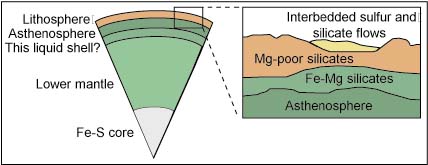
Io has differentiated into layers. Understanding the number and composition of the layers is still being studied. Most scientist agree there is a core surrounded by mantle. A simple 2-layer (metallic core and a silicate mantle) model suggests the core is about 17-20 percent of Io's mass and has a radius of about half of Io's radius (Anderson et al. 1996). Another model (that assumes a pure iron core) suggests the core is 11-14 percent of Io's mass and has a radius of about one-third of Io's radius. Schubert (1997) used a three-layer model to suggest the presence of a thick (100-250 km) outer layer on Io. Several lines of evidence indicate that Io's metallic core is at least partly molten. Some models call for Io to have silica-rich crust about 40-60 km thick. The crust would be made of alkali-rich minerals, probably feldspars and nepheline. Much of the mantle may be pure forsterite (magnesian-rich olivine).
The enormous gravitational forces of Jupiter cause heating within Io. Most of this heating is concentrated in the asthenosphere, estimated to be 50-100 km thick. Additional heating occurs deep in the mantle. Melting is probably located at the base of the lithosphere. Based on the amounts on energy released by Io's volcanoes each part of the interior has probably been remelted at least 100 times over the satellite's history.